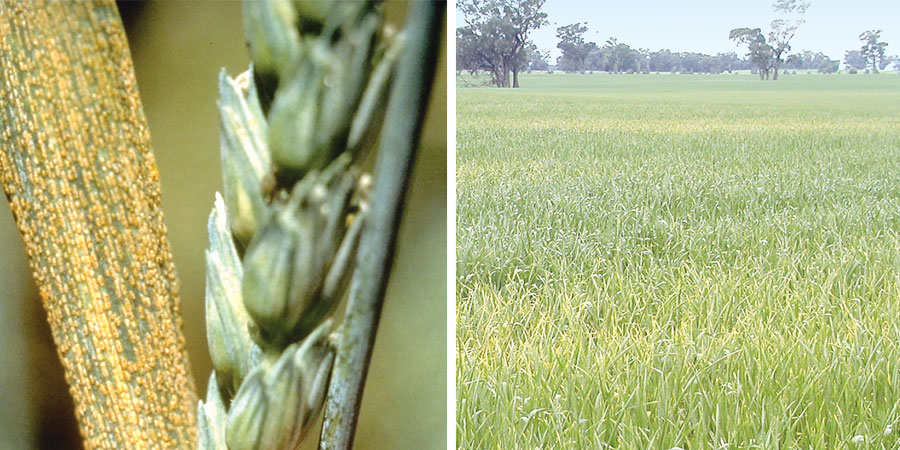Barley stripe rust (Puccinia striiformis f. sp hordei) poses a significant threat to wheat and barley production globally. Although not present in Australia, our grains industry is going to great lengths to keep this damaging disease out.
Barley stripe rust is a fungal disease that has impacted crop yield and grain quality across Europe, the UK, South America, Asia, Mexico and the US. Damage to barley plants varies depending on the plant growth stage. Crop losses are typically around 10 per cent, but in susceptible varieties they may be up to 100 per cent.
The disease is known to reduce plant and root growth, increase water loss and cut, resulting in fewer and lighter kernels.
The estimated potential cost to the Australian barley industry of an uncontrolled epidemic of leaf or stem rust is more than $100 million. This figure provides a benchmark for the potential impact of barley stripe rust in Australia and highlights the importance of strong biosecurity.
Early identification of symptoms, understanding the potential impacts on your crops, and implementing effective measures to help reduce the likelihood of it entering your property are key.

Left: Barley stripe rust symptoms. Right: Barley stripe rust ‘hotspots’ in crop. Photos: Plant Health Australia
Recognising the symptoms
Barley stripe rust primarily attacks the leaves, but a heavy infestation can also affect leaf sheaths and grain heads. The most notable symptom of stripe rust is the presence of yellow-orange pustules arranged in stripes on the upper leaf surface (above left). The disease is sometimes referred to as yellow rust.
In seedlings or highly susceptible varieties, the rust may cover the entire leaf and extend into the leaf sheaths and grain heads. The disease can build up rapidly if conditions are cool and wet, and infection is often first noticed as ‘hot spots’ or patches of lighter coloured crops within the crop (above right).
Stripe rust symptoms often appear earlier than other rusts due to lower temperature requirements for development.
In Australia, conditions for stripe rust development would be most conducive between April and December, with potential infestations becoming obvious in crops by September.
The optimum conditions for barley stripe rust spores are three to eight hours in high humidity, and temperatures ranging between 13°C to 18°C. However, spores can germinate in temperatures between 5°C to 20°C.
Disease similarities
Barley stripe rust can display similar symptoms to barley grass stripe rust and wheat stripe rust, which are established in Australia. It may also appear similar to other types of rust, such as wheat stem rust and barley leaf rust as shown in the images above, although these typically have spores that are browner in colour.
If you see any signs of stripe rust on barley, it is important to report it to the Exotic Plant Pest Hotline on 1800 084 881. The images illustrate the differences among the various types of rust, notably in spore colours.

Left: Stem rust on wheat. Photo: Yue Jin. Right: Barley leaf rust. Photo: Donald Goth
Protecting your farm and region
Barley stripe rust spores are small and light and can spread over large distances by wind. These spores can also attach to clothing, tools and machinery, facilitating their spread between farms across regions and even internationally. It is important to note that this disease is not seed borne.
Once introduced to a new region, there is high potential for spread, as demonstrated by the wind dispersal of this disease from Colombia to Chile in just a few years.
Measures to reduce risk are:
- regular monitoring – ensure you check crops frequently for any unusual symptoms;
- visitor hygiene – ask any visitors if they have travelled overseas recently and ensure all visitors come with clean clothing, tools, vehicles, and machinery;
- clean equipment – ensure that if you buy any machinery (new or second-hand), it is cleaned and inspected thoroughly before use, especially if it has been sourced from overseas; and
- remove volunteer plants – since rust resides within a living host to survive between seasons, ensure you manage or remove any volunteer plants such as barley and grasses to reduce the chance of the disease surviving and establishing. Keep green bridges under control, especially in the weeks prior to sowing.
If you spot anything unusual in your crop, call the Exotic Plant Pest Hotline on 1800 084 881. Document relevant details including GPS location, parts of the plant affected and variety, and take good-quality images showing close-ups of symptoms, as well as a photo of the entire plant.
For more information, refer to the Grains Farm Biosecurity Program’s (GFBP) fact sheet on barley stripe rust.
The GFBP is managed by Plant Health Australia and funded by growers through Grain Producers Australia together with the New South Wales, Queensland, South Australian, Victorian and Western Australian governments.
More information: grainsbiosecurity.com.au

























































